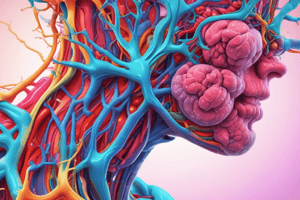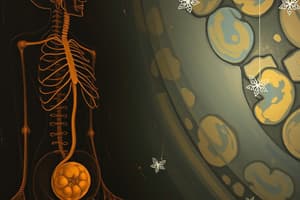Podcast
Questions and Answers
Which two major systems control body homeostasis?
Which two major systems control body homeostasis?
The nervous system and the endocrine system
What is the primary function of the endocrine glands?
What is the primary function of the endocrine glands?
To secrete hormones directly into the surrounding extracellular fluid.
What are hormones?
What are hormones?
Signaling molecules or chemical messengers that transport information from one set of cells to another.
What is the difference between endocrine, paracrine, and autocrine functions?
What is the difference between endocrine, paracrine, and autocrine functions?
Which of the following are examples of peptide or protein hormones?
Which of the following are examples of peptide or protein hormones?
Steroid hormones are stored in secretory granules within the endocrine gland.
Steroid hormones are stored in secretory granules within the endocrine gland.
What are two major sites for hormone degradation and elimination in the body?
What are two major sites for hormone degradation and elimination in the body?
What is the primary event that initiates a hormone response?
What is the primary event that initiates a hormone response?
What is the function of adenyl cyclase in the cAMP second messenger system?
What is the function of adenyl cyclase in the cAMP second messenger system?
Hormone receptor number remains constant throughout the lifespan of a cell.
Hormone receptor number remains constant throughout the lifespan of a cell.
What are the three main control mechanisms for hormone secretion?
What are the three main control mechanisms for hormone secretion?
What is the role of the hypothalamus in regulating pituitary gland secretion?
What is the role of the hypothalamus in regulating pituitary gland secretion?
What are the six major peptide hormones secreted by the anterior pituitary lobe?
What are the six major peptide hormones secreted by the anterior pituitary lobe?
What is the key function of growth hormone (GH)?
What is the key function of growth hormone (GH)?
What is the difference between dwarfism and gigantism?
What is the difference between dwarfism and gigantism?
What are some common clinical features of acromegaly?
What are some common clinical features of acromegaly?
What are the two major peptide hormones secreted by the posterior pituitary lobe?
What are the two major peptide hormones secreted by the posterior pituitary lobe?
What is the primary function of ADH?
What is the primary function of ADH?
Which of the following events can stimulate ADH release?
Which of the following events can stimulate ADH release?
What is the defining characteristic of diabetes insipidus?
What is the defining characteristic of diabetes insipidus?
Desmopressin is a selective V2 agonist, making it a preferred treatment option for central diabetes insipidus.
Desmopressin is a selective V2 agonist, making it a preferred treatment option for central diabetes insipidus.
What is the defining characteristic of SIADH?
What is the defining characteristic of SIADH?
Which of the following events can stimulate PTH secretion?
Which of the following events can stimulate PTH secretion?
What is the main function of calcitonin?
What is the main function of calcitonin?
What are the common causes of hypoparathyroidism?
What are the common causes of hypoparathyroidism?
Which of the following are classic clinical signs of hypoparathyroidism?
Which of the following are classic clinical signs of hypoparathyroidism?
What are the three most common etiologies of primary hyperparathyroidism?
What are the three most common etiologies of primary hyperparathyroidism?
Secondary hyperparathyroidism is usually associated with hypercalcemia.
Secondary hyperparathyroidism is usually associated with hypercalcemia.
What are the four cell types found in the islets of Langerhans?
What are the four cell types found in the islets of Langerhans?
What hormone is produced by the beta (ẞ) cells of the islets of Langerhans?
What hormone is produced by the beta (ẞ) cells of the islets of Langerhans?
What hormone is produced by the alpha (a) cells of the islets of Langerhans?
What hormone is produced by the alpha (a) cells of the islets of Langerhans?
What is the function of somatostatin?
What is the function of somatostatin?
What is the primary role of insulin in glucose metabolism?
What is the primary role of insulin in glucose metabolism?
What are the four main criteria for diagnosing diabetes?
What are the four main criteria for diagnosing diabetes?
What is the defining characteristic of Type 1 Diabetes Mellitus?
What is the defining characteristic of Type 1 Diabetes Mellitus?
What are some defining features of Type 2 Diabetes Mellitus?
What are some defining features of Type 2 Diabetes Mellitus?
What is the defining characteristic of diabetic ketoacidosis (DKA)?
What is the defining characteristic of diabetic ketoacidosis (DKA)?
What is the defining characteristic of hyperglycemic hyperosmolar state (HHS)?
What is the defining characteristic of hyperglycemic hyperosmolar state (HHS)?
What are the three layers of the adrenal cortex?
What are the three layers of the adrenal cortex?
What is the main function of aldosterone?
What is the main function of aldosterone?
What are some common symptoms of primary aldosteronism?
What are some common symptoms of primary aldosteronism?
What is the key function of cortisol?
What is the key function of cortisol?
Cortisol can be synthesized and released in response to both physical and mental stress.
Cortisol can be synthesized and released in response to both physical and mental stress.
What is a common clinical sign of Cushing syndrome?
What is a common clinical sign of Cushing syndrome?
What are the names of the three major categories of adrenal hormones?
What are the names of the three major categories of adrenal hormones?
Primary adrenal insufficiency is characterized by a deficiency of all adrenal hormones.
Primary adrenal insufficiency is characterized by a deficiency of all adrenal hormones.
Secondary adrenal insufficiency results from inadequate ACTH production, while primary adrenal insufficiency results from destruction of the adrenal glands.
Secondary adrenal insufficiency results from inadequate ACTH production, while primary adrenal insufficiency results from destruction of the adrenal glands.
What are the most common symptoms of acute adrenal crisis?
What are the most common symptoms of acute adrenal crisis?
What is the primary function of the adrenal medulla?
What is the primary function of the adrenal medulla?
What are the two main metabolic pathways for catecholamines?
What are the two main metabolic pathways for catecholamines?
What is the most common cause of pheochromocytomas?
What is the most common cause of pheochromocytomas?
What is the classical triad of symptoms for pheochromocytoma?
What is the classical triad of symptoms for pheochromocytoma?
What are some common clinical manifestations of pheochromocytoma?
What are some common clinical manifestations of pheochromocytoma?
Most patients with pheochromocytoma will present with hypertension.
Most patients with pheochromocytoma will present with hypertension.
Preoperative management of patients with pheochromocytoma is primarily focused on a-adrenergic blockade.
Preoperative management of patients with pheochromocytoma is primarily focused on a-adrenergic blockade.
What are some important things to consider during the perioperative management of a patient with pheochromocytoma?
What are some important things to consider during the perioperative management of a patient with pheochromocytoma?
What are some common clinical manifestations of hypothyroidism?
What are some common clinical manifestations of hypothyroidism?
The most common cause of hypothyroidism is Hashimoto thyroiditis.
The most common cause of hypothyroidism is Hashimoto thyroiditis.
What are some important considerations for perioperative anesthetic management of a patient with hypothyroidism?
What are some important considerations for perioperative anesthetic management of a patient with hypothyroidism?
What is the defining characteristic of myxedema coma?
What is the defining characteristic of myxedema coma?
The thyroid gland is located anterior to the trachea between the cricoid cartilage and the suprasternal notch.
The thyroid gland is located anterior to the trachea between the cricoid cartilage and the suprasternal notch.
What are the two main thyroid hormones produced by the thyroid gland?
What are the two main thyroid hormones produced by the thyroid gland?
What is the primary effect of thyroid hormones on cellular metabolism?
What is the primary effect of thyroid hormones on cellular metabolism?
TSH release is stimulated by high circulating levels of T3 and T4.
TSH release is stimulated by high circulating levels of T3 and T4.
What are the most common causes of hyperthyroidism?
What are the most common causes of hyperthyroidism?
Graves' disease typically affects women more often than men.
Graves' disease typically affects women more often than men.
What are some common clinical features of hyperthyroidism?
What are some common clinical features of hyperthyroidism?
What are the three primary treatment options for thyrotoxicosis?
What are the three primary treatment options for thyrotoxicosis?
Total thyroidectomy is the preferred treatment for Graves' disease.
Total thyroidectomy is the preferred treatment for Graves' disease.
What are some common complications associated with thyroid surgery?
What are some common complications associated with thyroid surgery?
What are some key anesthesia implications for patients with hyperthyroidism?
What are some key anesthesia implications for patients with hyperthyroidism?
What is thyroid storm?
What is thyroid storm?
What are some defining clinical features of thyroid storm?
What are some defining clinical features of thyroid storm?
What is the most common cause of hypothyroidism?
What is the most common cause of hypothyroidism?
Myxedema coma is a life-threatening condition that can develop quickly in patients with hypothyroidism.
Myxedema coma is a life-threatening condition that can develop quickly in patients with hypothyroidism.
What are the key aspects of managing a patient with myxedema coma?
What are the key aspects of managing a patient with myxedema coma?
The presence of pheochromocytomas is always associated with a family history of endocrine disorders.
The presence of pheochromocytomas is always associated with a family history of endocrine disorders.
Flashcards
Endocrine System
Endocrine System
A system of glands that secrete hormones directly into the bloodstream to regulate bodily functions.
Hormones
Hormones
Chemical messengers that travel through the bloodstream to target cells, triggering specific responses.
Endocrine Glands
Endocrine Glands
Organs that produce and secrete hormones.
Peptide/Protein Hormones
Peptide/Protein Hormones
Signup and view all the flashcards
Steroid Hormones
Steroid Hormones
Signup and view all the flashcards
Tyrosine Derivative Hormones
Tyrosine Derivative Hormones
Signup and view all the flashcards
Endocrine Function
Endocrine Function
Signup and view all the flashcards
Paracrine Function
Paracrine Function
Signup and view all the flashcards
Autocrine Function
Autocrine Function
Signup and view all the flashcards
Hormone Transport
Hormone Transport
Signup and view all the flashcards
Hormone Receptors
Hormone Receptors
Signup and view all the flashcards
Second Messengers
Second Messengers
Signup and view all the flashcards
cAMP System
cAMP System
Signup and view all the flashcards
Hormone Receptor Activation
Hormone Receptor Activation
Signup and view all the flashcards
Negative Feedback
Negative Feedback
Signup and view all the flashcards
Positive Feedback
Positive Feedback
Signup and view all the flashcards
Pituitary Gland
Pituitary Gland
Signup and view all the flashcards
Anterior Pituitary Lobe
Anterior Pituitary Lobe
Signup and view all the flashcards
Growth Hormone (GH)
Growth Hormone (GH)
Signup and view all the flashcards
Acromegaly
Acromegaly
Signup and view all the flashcards
Hypocalcemia
Hypocalcemia
Signup and view all the flashcards
Hyperparathyroidism
Hyperparathyroidism
Signup and view all the flashcards
Hypoparathyroidism
Hypoparathyroidism
Signup and view all the flashcards
Diabetes Insipidus (DI)
Diabetes Insipidus (DI)
Signup and view all the flashcards
SIADH
SIADH
Signup and view all the flashcards
Endocrine System: Regulation
Endocrine System: Regulation
Signup and view all the flashcards
Endocrine vs. Exocrine Glands
Endocrine vs. Exocrine Glands
Signup and view all the flashcards
Study Notes
The Endocrine System and Anesthesia
- Body homeostasis is regulated by the nervous and endocrine systems, which communicate and organize the body's response to internal and external changes.
- Endocrine glands secrete hormones directly into the extracellular fluid, regulating behavior, growth, metabolism, fluids, electrolytes, development, and reproduction.
- Major endocrine glands include the pituitary, thyroid, parathyroid, adrenal, pancreas, ovaries, testes, and placenta.
Hormones
- Hormones are chemical messengers transporting information between cells.
- Released in minute quantities from endocrine glands into body fluids.
- Types of hormones: proteins/peptides, tyrosine amino acid derivatives, steroids
Hormone Transmission
- Endocrine: Hormone signals travel through the bloodstream to distant target cells.
- Paracrine: Hormone signals act on neighboring cells of a different type.
- Autocrine: Secreted hormone acts on the producer cell itself.
Hormone Receptors
- Hormone receptors display high specificity and affinity for their specific hormone ligand.
- Location directs hormones to target organs/cells.
- Receptors are located on cell membranes, in the cytoplasm, or in the nucleus.
- Membrane receptors activate intracellular pathways.
- Intracellular receptors affect DNA and gene transcription/translation, leading to protein synthesis.
Hormone Receptor Activation
- Membrane receptors trigger intracellular signals (second messengers) such as cAMP.
- cAMP is generated through adenyl cyclase activation.
- Other second messengers include calcium, diacylglycerol, inositol triphosphate, and cyclic guanosine monophosphate.
- Thyroid and steroid hormones interact with intracellular receptors to influence gene expressions.
Hormone Secretion Regulation
- Neural controls: Stimulate or suppress hormone secretion, such as pain, emotions, smell etc.
- Biorhythms: Govern by genetically encoded oscillations (circadian, weekly, seasonal).
- Feedback mechanisms: Negative feedback limits hormone production after appropriate response.
- Positive feedback: Hormone response initiating more hormone release (e.g., LH surge before ovulation).
Pituitary Gland
- The pituitary gland (hypophysis) is the "master endocrine gland."
- It secretes hormones with far-reaching effects on various functions (homeostatic, developmental, metabolic, reproductive).
- Anterior pituitary: Composed of multiple cell types including somatotrophs (GH), gonadotrophs (LH/FSH), thyrotrophs (TSH), corticotrophs (ACTH), and lactotrophs (prolactin).
- Posterior pituitary: Stores/releases hormones synthesized in the hypothalamus (ADH/vasopressin, oxytocin).
Anterior Pituitary Disorders
- Hyposecretion: Caused by tumors or other destructive processes.
- Hypersecretion: Caused primarily by benign adenomas.
- Examples of syndromes: prolactin-secreting tumors (galactorrhea, amenorrhea); ACTH-secreting tumors (Cushing disease); growth hormone-secreting tumors (acromegaly or gigantism).
Growth Hormone
- GH (somatotropin) stimulates skeletal development/growth, IGF-1 production, and has metabolic effects.
- Secretion is regulated by hypothalamic hormones (GH-releasing, growth hormone inhibitory factor/somatostatin).
- Hyposecretion: Dwarfism.
- Hypersecretion: Acromegaly (adult), gigantism (childhood).
Antidiuretic Hormone (ADH)
- ADH regulates water reabsorption in kidneys and serum osmolarity.
- Released by osmotic receptors in hypothalamus in response to water deprivation, volume loss, or low BP.
- Diabetes Insipidus: Insufficient ADH or impaired renal response to ADH results in polyuria, dehydration, and hypernatremia.
- Excessive ADH (SIADH): Excessive ADH despite normal or low serum osmolarity results in hyponatremia and water retention.
Adrenal Gland
- Adrenal cortex (outer): Secretes mineralocorticoids (aldosterone), glucocorticoids (cortisol), androgens.
- Adrenal medulla (inner): Secretes catecholamines (epinephrine/norepinephrine).
Adrenal Gland Disorders
- Hyperaldosteronism: Excessive aldosterone resulting in hypertension and hypokalemia (Conn's syndrome).
- Cushing syndrome: Excess glucocorticoids resulting in characteristic physical changes (central obesity, moon face, buffalo hump), metabolic alterations (diabetes, osteoporosis) etc.
- Adrenal insufficiency: Deficient hormone production.
Pancreas
- Exocrine function: Secretes digestive enzymes and bicarbonate.
- Islets of Langerhans (endocrine): Insulin (beta cells), glucagon (alpha cells), somatostatin (delta cells).
Glucose Homeostasis
- Glucose is the primary body fuel; its concentration is tightly regulated.
- Insulin promotes glucose storage (glycogenesis) and utilization in various tissues.
- Glucagon promotes glycogen breakdown and glucose release in the liver.
- Counterregulatory hormones (GH, cortisol, epinephrine) oppose the effects of insulin.
- Hypoglycemia: Low blood glucose.
- Hyperglycemia: High blood glucose.
- Diabetes Mellitus: Characterized by impaired insulin secretion or function, leading to hyperglycemia. Two main types: Type 1 (absolute insulin deficiency) and Type 2 (impaired insulin secretion/resistance).
- Diabetic ketoacidosis (DKA): Severe metabolic complication of type 1 diabetes, characterized by hyperglycemia, ketonemia, and acidosis.
- Hyperglycemic hyperosmolar state (HHS): Severe metabolic complication of type 2 diabetes, characterized primarily by severe hyperglycemia and dehydration.
Thyroid Gland
- The thyroid gland produces and releases T3/T4.
- Synthesis involves iodide trapping, oxidation, organification, and coupling reactions.
- T4 is converted to T3 for most of its functions.
- Hypothyroidism: Insufficient thyroid hormone resulting in a decreased metabolic rate, cold intolerance, weight gain.
- Hyperthyroidism: Excessive thyroid hormone resulting in an increased metabolic rate, heat intolerance, weight loss, tachycardia.
Thyroid Disorders
- Graves disease: Autoimmune disorder that results in hyperthyroidism.
- Thyroid storm (Thyrotoxic crisis): Acute, life-threatening complication of uncontrolled hyperthyroidism associated with high fever, tachycardia, and other cardiovascular and neurologic symptoms.
Adrenal Medulla
- Chromaffin cells synthesize/release catecholamines.
- Norepinephrine and epinephrine are the key hormones.
Adrenal Medulla Disorders
- Pheochromocytoma: Tumor of the adrenal medulla leading to excessive catecholamine release, resulting in hypertension, tachycardia, and other symptoms.
Studying That Suits You
Use AI to generate personalized quizzes and flashcards to suit your learning preferences.




